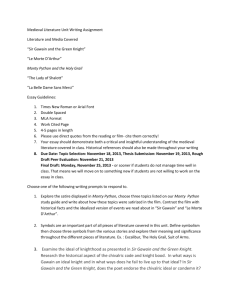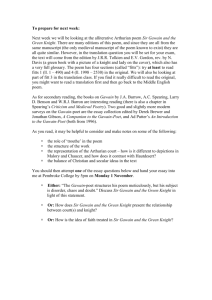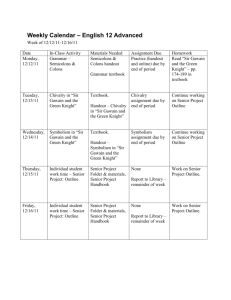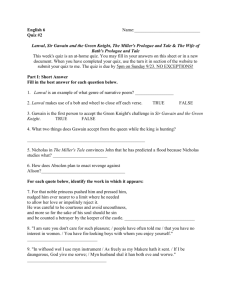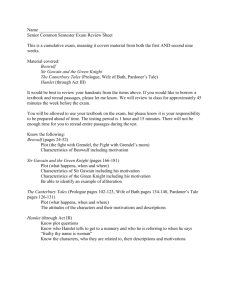Stephanie Newman English 41 Final Paper Feminine Power: The
advertisement
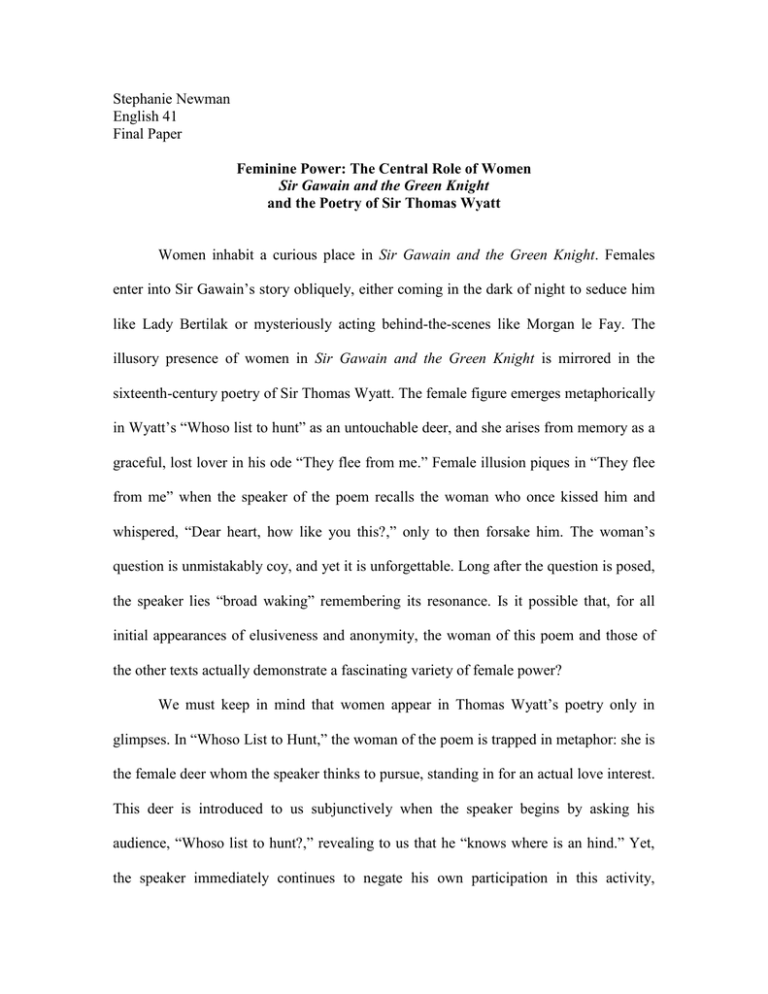
Stephanie Newman English 41 Final Paper Feminine Power: The Central Role of Women Sir Gawain and the Green Knight and the Poetry of Sir Thomas Wyatt Women inhabit a curious place in Sir Gawain and the Green Knight. Females enter into Sir Gawain’s story obliquely, either coming in the dark of night to seduce him like Lady Bertilak or mysteriously acting behind-the-scenes like Morgan le Fay. The illusory presence of women in Sir Gawain and the Green Knight is mirrored in the sixteenth-century poetry of Sir Thomas Wyatt. The female figure emerges metaphorically in Wyatt’s “Whoso list to hunt” as an untouchable deer, and she arises from memory as a graceful, lost lover in his ode “They flee from me.” Female illusion piques in “They flee from me” when the speaker of the poem recalls the woman who once kissed him and whispered, “Dear heart, how like you this?,” only to then forsake him. The woman’s question is unmistakably coy, and yet it is unforgettable. Long after the question is posed, the speaker lies “broad waking” remembering its resonance. Is it possible that, for all initial appearances of elusiveness and anonymity, the woman of this poem and those of the other texts actually demonstrate a fascinating variety of female power? We must keep in mind that women appear in Thomas Wyatt’s poetry only in glimpses. In “Whoso List to Hunt,” the woman of the poem is trapped in metaphor: she is the female deer whom the speaker thinks to pursue, standing in for an actual love interest. This deer is introduced to us subjunctively when the speaker begins by asking his audience, “Whoso list to hunt?,” revealing to us that he “knows where is an hind.” Yet, the speaker immediately continues to negate his own participation in this activity, declaring, “But as for me, alas! I may no more.” The activity of hunting this female deer is thus placed into the realm of possibility, not grounded in actuality. The female deer enters the poem merely as an idea in the speaker’s mind. When the poem does commit more lines to describing the deer, it only places her farther out of reach, as she “fleeth” from the speaker, and by extension the reader. The woman of the poem is then intangible in two ways: she is metaphorized as a deer, and she is also rendered unobtainable as an animal in flight. The speaker acknowledges that to seek her out would be to “seek to hold the wind” within in a net. He warns that any other man who tries to catch her will “spend his time in vain,” and so we realize the impossibility of the pursuit. We could even ascribe a darker reading of this female deer, noting that she is not even allowed free will. She is intangible to us because she is owned by somebody else: Caesar, who marks her as his possession with the engraved collar placed round her neck. In “Whoso list to hunt,” the female is only a shadow of a full human being. Just as the female in “Whoso list to hunt” exists only in metaphorical context, so we see that the female in “They flee from me” emerges not as an active character, but as a figure of the speaker’s memory. The speaker, who now finds himself deserted, recalls a time when his fortune was “twenty times better.” This reminiscence leads directly to a special recollection involving his love interest: “In thin array, after a pleasant guise, / When her loose gown from her shoulders did fall, / And she me caught in her arms long and small, / Therewithal sweetly did me kiss / And softly said, “Dear heart, how like you this?” The female in question occupies only the space of the speaker’s memory in the poem; he relays to us only the details about this woman that he wishes us to know, and he gives her only the amount of attention he decides she deserves. He renders her vulnerable and delicate, her gown slipping from her shoulders and her arms long and small. The description of her physique is limited to her torso, and so we cannot even construct for ourselves an image of this woman’s face. Her presence in the poem is mysterious and restricted. Similarly, the women in Sir Gawain and the Green Knight enter the text only in oblique and illusory roles. Lady Bertilak, the female whom we see with most recurrence in the text, isn’t even privileged enough to be called by her proper name. She is simply “the lady, with guile in heart,” who “coyly peeps in” to Gawain’s bedchamber and tries to seduce him. The description we receive of this lady is also purely physical: she arrives for the first time in his chamber with “blent white and red on cheek,” and in her final visit, she comes “in a fair, flowing mantle that fell to the earth” with her “bosom all but bare, and her back as well” (1206; 1736-1741). Though she is a repeated presence in the text, she is represented more for her appearance than for her character. In the dialogue that she is allowed, Lady Bertilak divests herself of power, telling Gawain, “My body is here at hand, / Your each wish to fulfill; / Your servant to command / I am, and shall be still” (1237-1240). She invites him to use her as he pleases, thereby presenting herself as a passive figure ready to surrender herself to Gawain’s whims. Even more strikingly, we later find out that Lady Bertilak is actually being controlled by her husband, who at the end of the trial reveals to Gawain, “And the wooing of my wife—it was all my scheme!” (2361). Bertilak directs his wife to seduce Gawain to see how strongly the man can hold out against temptation. Lady Bertilak is a puppet in a calculated game. When Bertilak finally discloses to Gawain and the reader that the engineer behind the whole scheme is King Arthur’s mischievous half-sister Morgan le Faye, the limited role of women in the text seems more outstanding than ever. How is it that the female sorceress who is responsible for Gawain’s entire adventure is only briefly referenced in a conversation between two male characters? The temporality of our discovery is also important to note, for Morgan receives no recognition for her prowess until the very end of the story, becoming visible only after the game she has designed is already over. And yet, if we sharpen our perceptions, we can see that the elusiveness of Morgan le Fay and the other women of these texts is its own version of female power. Turning back to Wyatt’s poetry, we see that the female deer in “Whoso list to hunt” demonstrates her power over the speaker by refusing to be possessed by him. He knows where she is, but he cannot catch her. She is as fast as the wind, forcing the speaker to faint as he follows her and to “leave off” before he can even hope to reach her. The occasion of the poem is the speaker’s recognition of the female figure’s ultimate victory over her male courters. The female triumphs when the speaker acknowledges his failure to dominate her. Besides being the central subject of the poem, the female deer gives rise to the most beautiful image within the sonnet. In the final four verses of “Whoso list to hunt,” Wyatt writes of the hind, “And graven with diamonds in letters plain / There is written, her fair neck round about, / “Noli me tangere, for Caesar’s I am, / And wild for to hold, though I seem tame.” The female deer sparkles in coveted jewels at her most powerful moment in the poem. The message she conveys in this moment is in the first-person, and it is the Latin command translating to, “Do not touch me.” Thus the poem ends on an instruction from the female to the speaker. She asserts herself by telling the speaker that he may not touch her and revealing to him and the reader that she is more than she appears. The hind is not tame after all; she is authoritative, didactic, and in control. Likewise, the female figure in “They flee from me” illuminates the most memorable stanza of the poem. Not only does the female figure physically inhabit the center spot in the three-stanza ode; she also exists in the center of the speaker’s very own psyche. The fact that she is conveyed as a memory does not diminish her power but strengthens it, for she comes to life as the only distinguished figure the speaker describes. Though the speaker recollects a general group of people who once walked softly in his chamber but now flee from him, he cares only to reveal in particular the woman who once sweetly kissed him. She is the one in power, the one who directs the thoughts of the speaker with her question to his heart, and the one whose arms—“long and small” as they might be—catch the speaker within them. The same can be said about Lady Bertilak of Sir Gawain and the Green Knight. Though Lady Bertilak appears passive in telling Gawain that he is welcome to her body, she really demonstrates her female power through her role as a temptress. She remains in control through each encounter with Gawain, from the moment she “stepped stealthfully, and stole to his bed” to when she assertively tells him that she desires to “keep company awhile with [her] captive knight” (1191- 1225). Lady Bertilak is the temptation that Gawain must resist in order to successfully complete his mission, and so she assumes the position of power over Gawain. Her effect on Gawain is permanent: because he does not come clean with the girdle she has given him, the Green Knight inflicts a slight wound on Gawain’s neck during the third blow of the axe. Gawain must live with an everlasting mark on his neck, the mark of Lady Bertilak and the power she exercised over him during his stay at the Castle. Reconsidering the portrayal of Morgan la Fey, we must admit that her limited mention at the end of the text cannot discount the fact that she is the artist behind the game. The appearance that the game is played between two males, Sir Gawain and the Green Knight, is just that: an appearance. The real director of the game is a shrewd woman, and our delay in learning that Morgan la Fay controls the action is only the result of how particularly her scheme is planned. She is not revealed to Gawain sooner simply so that he should not suspect the artistry behind what he takes seriously to be a game of life or death. The fact that she succeeds in keeping Gawain and the reader in darkness until the end of the game is an attribute to her triumph. The revelation of Morgan le Fay’s role at the end also frames the text. Her game with the Green Knight is contrived to “afflict the fair queen” Guenevere, who is the first woman we encounter sitting gaily in the court of Camelot. Guenevere and Morgan le Fay occupy our first and last thoughts, and so the two women stand like bookends at the start and end of the story. If we leave Sir Gawain and the Green Knight with women on our minds, then so too does Gawain. After the artfulness of Lady Bertilak is revealed, Gawain muses aloud on the role of women in his story and throughout history: “But if a dullard should dote, deem it no wonder, / And through the wiles of a woman be wooed into sorrow, / For so was Adam by one, when the world began, / And Solomon by many more, and Samson the mighty” (2414-2417). Gawain, embarrassed by his own vulnerability to women, belittles their power. He suggests that women are wily and deceitful, nodding to the other prominent male figures in history who “one and all fell prey” to women (2425-2426). But we know better than to subscribe to Gawain’s bitterness. Like Sir Thomas Wyatt, he has simply found himself caught in the “arms long and small” of a woman whose power has far exceeded his expectations.

